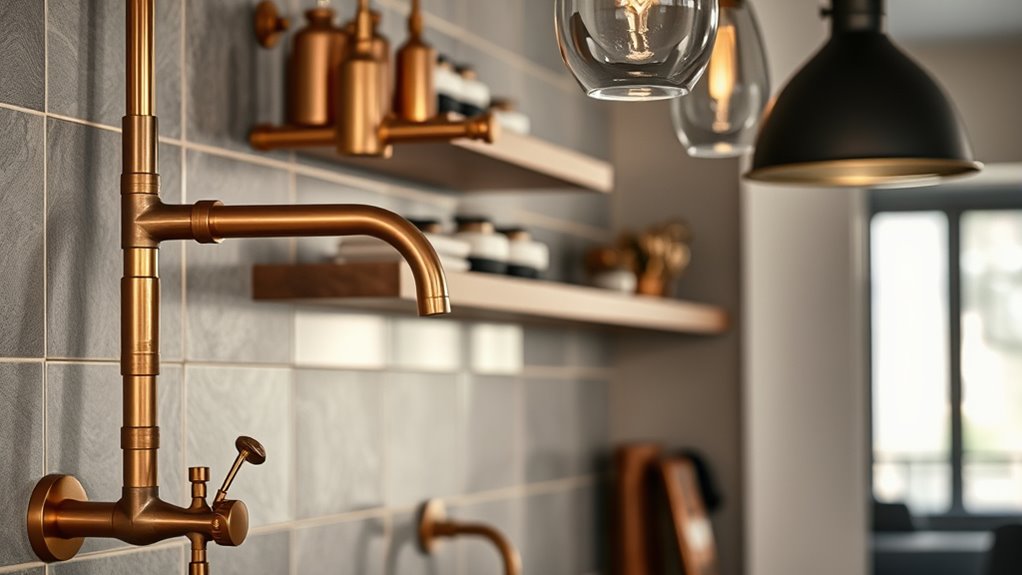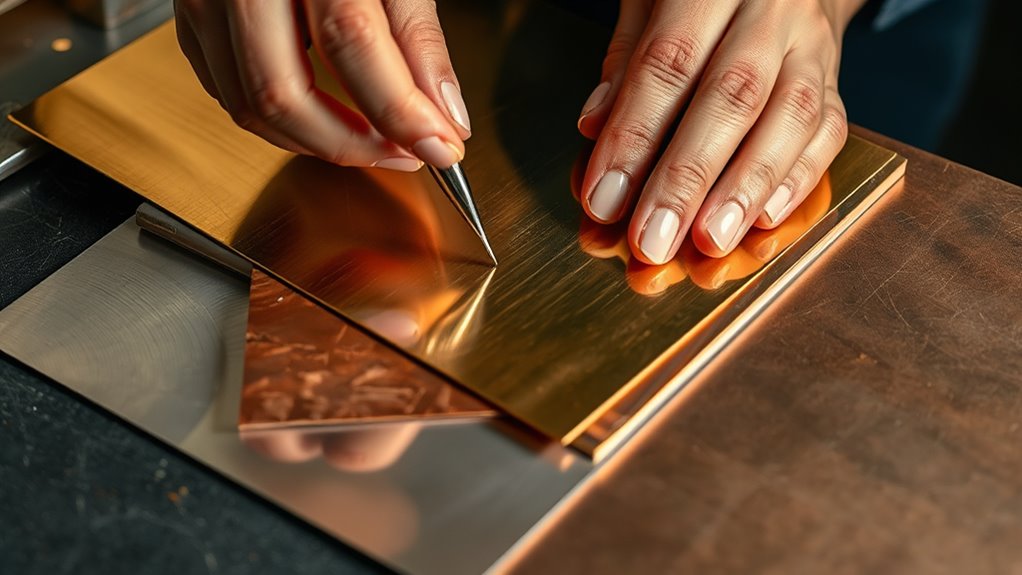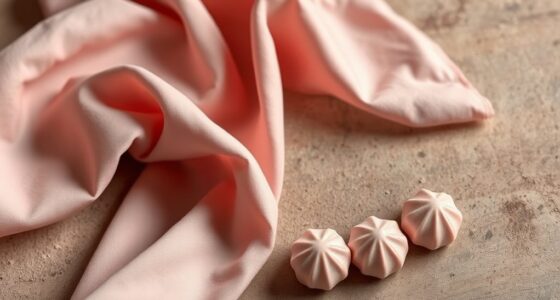To master mixing metals, choose a dominant metal to set the tone and add accent metals for contrast. Balance warm tones like brass with cool tones like chrome, using neutral backgrounds to unify your look. Mix finishes like matte, brushed, or polished for texture and depth. Pair metals with similar undertones or complementary colors to create harmony, and experiment with contrasts to keep things interesting. Exploring these tips further will help you elevate your style seamlessly.
Key Takeaways
- Choose a dominant metal as the focal point before incorporating complementary and accent metals.
- Mix warm and cool metals thoughtfully, balancing with neutral backgrounds and textured finishes for harmony.
- Use contrasting finishes like matte and polished to add depth and visual interest.
- Incorporate metals with similar undertones to enhance cohesion and avoid clashing.
- Consider color psychology and trends to select metal hues that evoke desired moods and styles.
Understanding Different Metal Finishes and Their Characteristics

Different metal finishes offer a wide range of aesthetics and durability, making it important to comprehend their unique characteristics. Metal patinas create aged, textured, or colored effects that add character and depth to surfaces, ideal for vintage or rustic styles. Brushed finishes, on the other hand, give metals a soft, matte look with subtle texture, reducing glare and hiding fingerprints. These finishes respond differently to wear and cleaning; patinas may develop more appeal over time, while brushed finishes tend to maintain their appearance with minimal maintenance. Recognizing the differences helps you choose the right finish for your space’s style and function. Whether aiming for a weathered look or a sleek, understated surface, understanding these options ensures your design choices complement each other and stand the test of time. Additionally, staying informed about automation in industry can inspire innovative ideas for integrating metal finishes into modern, efficient designs.
Balancing Warm and Cool Tones for Cohesive Designs

To create a balanced look, start by pairing warm and cool metals thoughtfully, ensuring they complement rather than clash. Using neutral backdrops helps unify the different tones, making the mix feel intentional. Incorporating textured finishes adds depth and interest, tying the elements together seamlessly. Paying attention to metal finishes can further enhance the cohesion and visual harmony of your decor.
Pairing Warm With Cool
Balancing warm and cool tones can create a harmonious and inviting space when you choose the right pairings. To achieve this, consider these key strategies:
- Mix metals like brass (warm) and chrome (cool) for visual interest, aligning with current seasonal color trends.
- Use cool-toned metals as accent pieces to offset warm wall colors or furniture.
- Incorporate cultural metal symbolism—such as gold representing prosperity and silver for clarity—to add meaning and depth.
- Layer textures and finishes to soften contrasts, ensuring the blend feels intentional rather than jarring.
- Selecting high-quality metal finishes can enhance durability and aesthetic cohesion in your design.
Using Neutral Backdrops
Using neutral backdrops provides the perfect canvas for mixing warm and cool metals seamlessly. A neutral background creates a subtle contrast that highlights different metal tones without overwhelming the space. It helps balance the visual weight of warm golds and cool silvers, ensuring cohesion. When choosing your backdrop, opt for shades like beige, soft gray, or taupe. These colors complement both warm and cool finishes, allowing your metals to stand out harmoniously. To visualize the effect:
| Warm Metals | Cool Metals |
|---|---|
| Gold, brass, rose gold | Chrome, nickel, silver |
| Subtle contrast enhances cohesion | Creates a balanced, elegant look |
This approach simplifies mixing metals for a unified, inviting space. Research supports the use of neutral tones in interior design for achieving harmony between contrasting elements.
Incorporating Textured Finishes
Incorporating textured finishes adds depth and visual interest to your metal mix, making it easier to harmonize warm and cool tones. Tactile contrasts created by textured finishes enhance the overall aesthetic, adding dimension and richness. To effectively balance warm and cool metals with textured finishes, consider these tips:
- Use textured finishes on warm metals like brass or gold to highlight their richness.
- Apply tactile contrasts with cool metals such as chrome or brushed nickel to add subtle variety.
- Mix smooth and textured surfaces to create visual depth without overwhelming the space.
- Focus on consistency in texture style to maintain cohesion across different finishes.
- Incorporate self-watering planters in your design to add functional texture and complement your metal accents.
Choosing a Dominant Metal to Anchor Your Look

Have you ever wondered how to choose a metal that truly defines your jewelry look? The key lies in metal dominance, which sets the tone for your entire collection. Start with focal point selection—decide which piece will draw the most attention, like a statement necklace or bold bracelet. This piece should be crafted in your dominant metal, such as gold, silver, or rose gold, to create a cohesive foundation. Keep in mind that your dominant metal will guide the overall mood and style, whether elegant, modern, or edgy. Once you’ve established this focal point, you can introduce complementary metals for subtle contrast. Choosing a dominant metal isn’t just about preference; it’s about creating a balanced, impactful look that reflects your personal style. Additionally, understanding the best metal matches can help you coordinate your jewelry for a polished appearance.
Incorporating Accent Metals for Visual Interest

Adding accent metals can instantly boost your space’s visual appeal. By mixing finishes and balancing tones, you create a layered, cohesive look that catches the eye. Highlighting key areas with small metal accents draws attention and adds sophistication. To ensure harmony, consider metal matching principles when selecting different finishes.
Mixing Metal Finishes
Mixing metal finishes can dramatically enhance your space by creating visual interest and depth. To successfully incorporate accent metals, consider these tips:
- Vary your textures—combine matte, polished, and brushed finishes for contrast.
- Mix metals in different items like fixtures, hardware, or decor to add dimension.
- Use metal jewelry-inspired accessories to introduce subtle shine and personality.
- Incorporate industrial accents, such as steel or iron, for an edgy, modern touch.
- Incorporating sound vibrations can influence the ambiance and overall harmony of your space.
Balancing Metal Tones
Balancing metal tones is essential for creating a cohesive and visually appealing space when incorporating accent metals. You want to mix metals thoughtfully, avoiding a cluttered or chaotic look. Consider using metal jewelry or appliance finishes as inspiration—pair warm gold accents with brushed nickel or matte black to add depth. When you introduce accent metals, ensure they complement the primary finishes instead of competing with them. For example, if your fixtures are polished chrome, add subtle touches of bronze or brass for contrast. Keep the distribution balanced, so no single metal dominates. This approach helps create harmony and visual interest, making your space feel curated rather than disjointed. Properly balancing metal tones highlights each element without overwhelming the overall design. Additionally, understanding metal properties can guide you in selecting finishes that naturally complement each other and enhance your decor.
Highlighting With Accents
Incorporating accent metals is a powerful way to draw attention and create focal points within your space. Metal accenting adds visual interest through strategic placement of contrasting metals that highlight key features. To maximize impact, consider these tips:
- Use a bold metal finish like brass or copper against cooler tones to create striking color contrast.
- Incorporate small accent pieces, such as hardware or decor, to subtly enhance your design.
- Mix matte and polished finishes to add depth and texture.
- Highlight architectural details, like trim or moldings, with metallic accents that stand out.
- Be mindful of metal compatibility to ensure cohesive and harmonious design integration.
Tips for Mixing Metals in Home Decor and Fashion

To successfully combine different metals in your home decor or fashion, start by choosing a dominant metal as your focal point. Seasonal trends often influence which metals stand out, so consider current styles like warm brass or sleek silver. Cultural influences can also guide your choices, reflecting specific traditions or regional aesthetics. Once you’ve identified your main metal, incorporate other tones in smaller doses to create harmony. Mixing metals works best when you keep the overall palette balanced, avoiding cluttering with too many finishes. Trust your instincts, and don’t be afraid to experiment. Subtle contrasts, like matte and shiny finishes, can add depth. Interestingly, the global entertainment industry significantly influences popular styles and trends, which can inspire your metal pairing choices. Ultimately, blending metals is about expressing your style while respecting the visual flow of your space or outfit.
Color Matching Strategies to Enhance Metal Combinations

When mixing metals, choosing the right colors can make your combinations stand out even more. To optimize your metal pairing, consider these color matching strategies rooted in metal color psychology. First, use neutral shades like black, white, or gray to create a sophisticated contrast. Second, incorporate metallic hues that complement each other through similar undertones, enhancing harmony. Third, leverage contrasting colors such as deep blue or emerald to add vibrancy and visual interest. Fourth, explore metal coating techniques like matte or brushed finishes to influence how colors interact with the surface, affecting overall perception. Additionally, understanding metal color psychology can help you select hues that evoke specific moods and styles, making your decor or fashion projects more impactful. By understanding how metal color psychology influences mood and style, you can craft eye-catching, balanced metal combinations that elevate your decor or fashion projects.
Frequently Asked Questions
How Do Lighting Conditions Affect Metal Color Perception?
Lighting impact considerably influences your perception of metal colors. Under warm, yellow-toned lighting, metals may appear richer or more golden, while cool, bluish lighting can make them seem sleeker or more muted. You should consider your lighting conditions when choosing or matching metals, as they can alter how the colors look in your space. Adjusting lighting can help you see true metal hues and ensure your design choices look cohesive.
Can Mixing Metals Impact the Overall Aesthetic’s Longevity?
Mixing metals can impact your design’s longevity by risking metal corrosion if not done carefully, especially with incompatible alloys. However, when you choose metals with complementary tones and maintain design harmony, the aesthetic stays vibrant longer. Proper sealing and cleaning also help prevent corrosion, ensuring the mixed metals retain their beauty over time. So, with thoughtful selection and maintenance, your mixed-metal design can be both stunning and durable.
Are Certain Metals More Prone to Tarnishing When Combined?
Certain metals are more prone to tarnishing when combined, especially those with lower alloy stability like copper or brass. Metal corrosion can accelerate when incompatible metals contact each other, leading to tarnishing or discoloration. To minimize issues, you should choose metals with higher alloy stability, such as stainless steel or platinum, which resist corrosion better. Proper sealing and cleaning also help prevent tarnishing caused by metal interactions.
How Do Different Textures Influence Metal Color Matching?
Think of textures as the personality behind your jewelry. Matte surfaces soften bold metals, while shiny finishes make vibrant hues pop. When matching colors, consider surface finishes for a harmonious look—smooth with smooth, textured with textured. Pattern coordination also plays a role; mixing different textures adds depth, but too many can clash. By balancing surface finishes and patterns, you create a cohesive, eye-catching ensemble that feels effortless and refined.
What Are the Best Cleaning Practices for Mixed-Metal Designs?
You should follow a consistent cleaning schedule to maintain mixed-metal designs. Use a gentle metal polish suitable for each metal type, avoiding harsh abrasives that can damage finishes. Regularly wipe down your pieces with a soft cloth to prevent tarnish and fingerprints. For stubborn spots, apply polish carefully and buff gently. This routine preserves their beauty and prevents discoloration, ensuring your mixed-metal pieces stay vibrant and well-maintained over time.
Conclusion
So, you’ve mastered the art of mixing metals—who knew it was so simple? Just pick a dominant metal, toss in some accents, and match those colors like a pro. Now, your home and wardrobe are practically shouting, “Look at me, I’m stylish!” Remember, if all else fails, just blame it on creative chaos. After all, in the world of mixed metals, perfection is overrated—embrace the beautiful mess.










